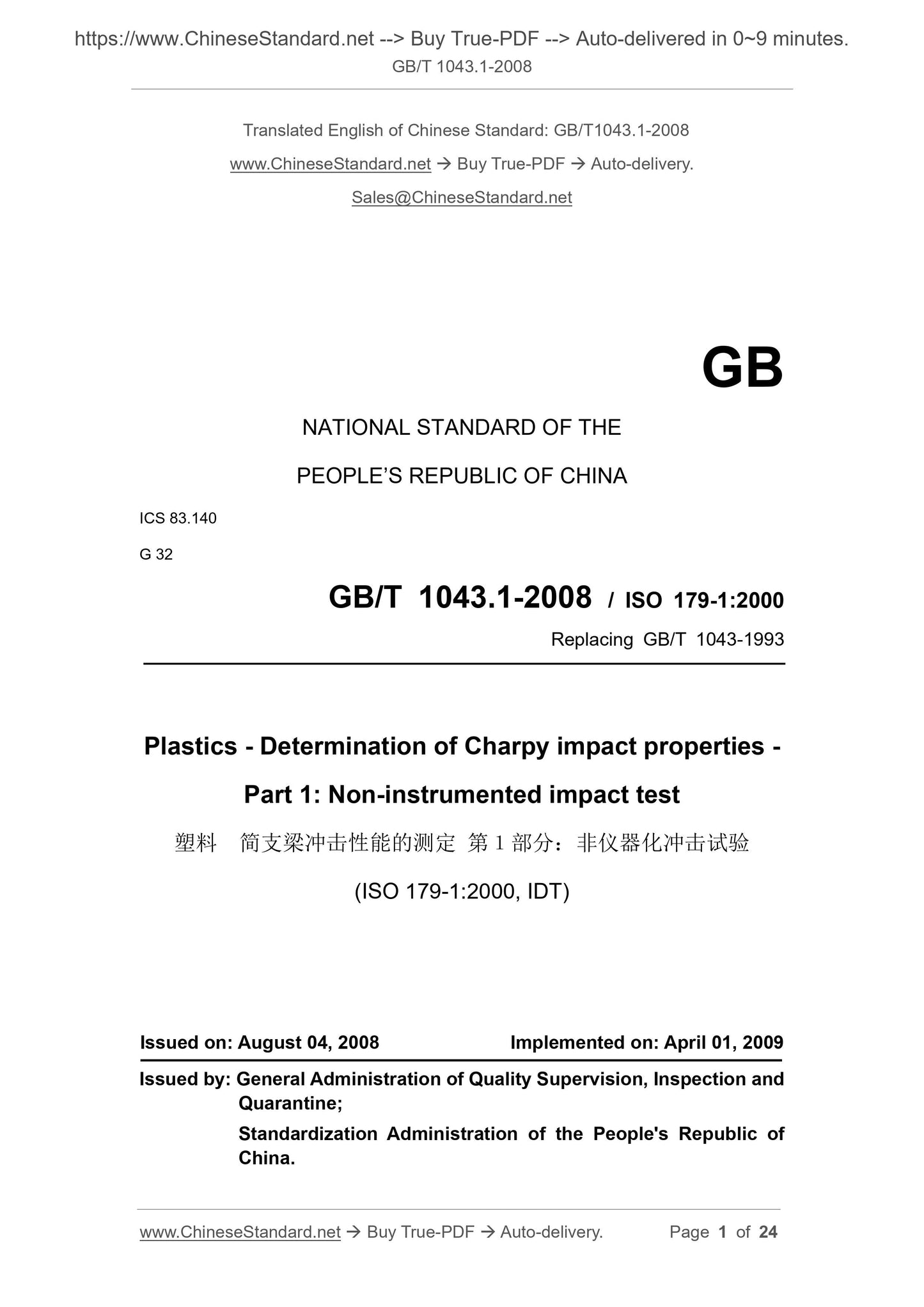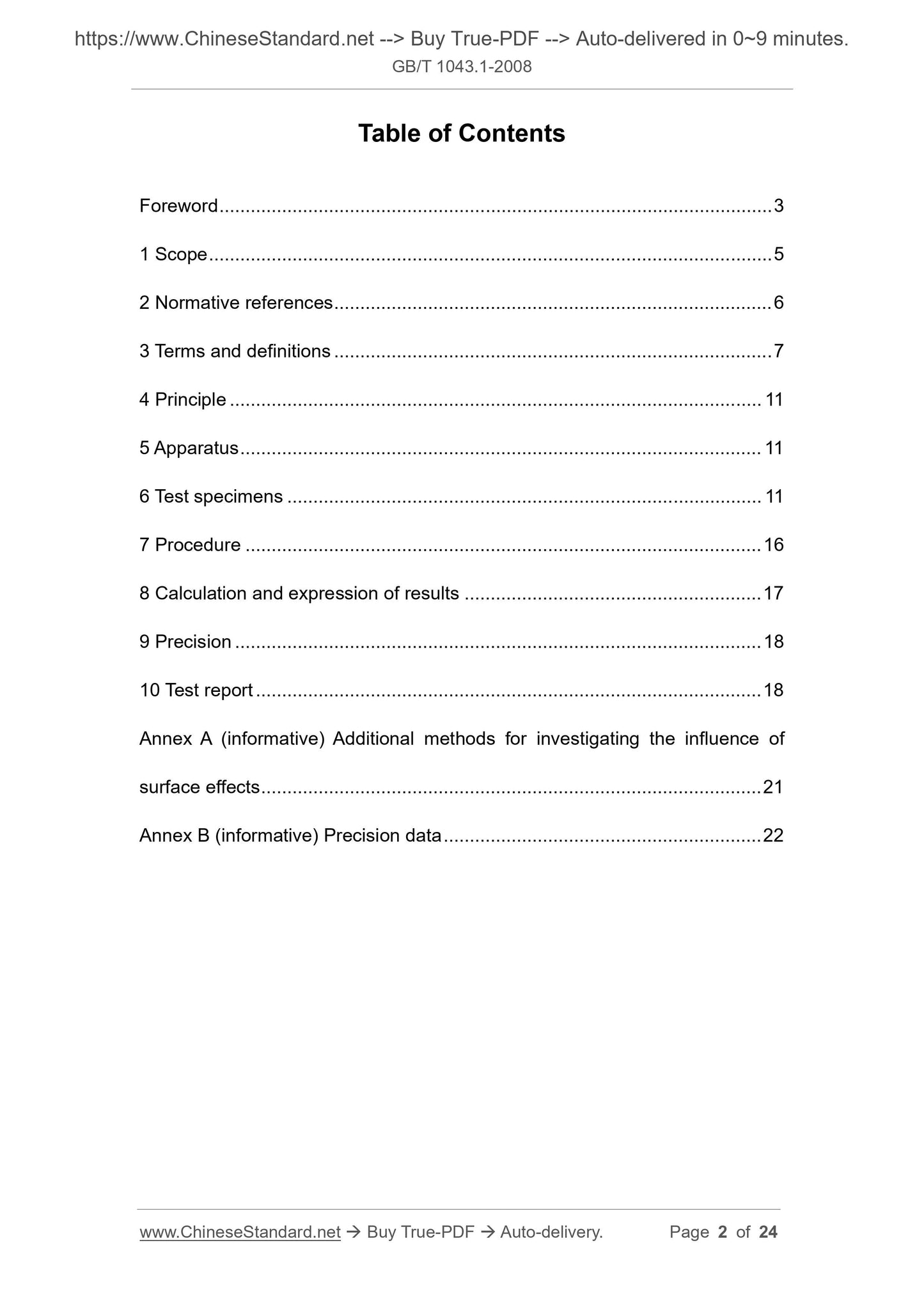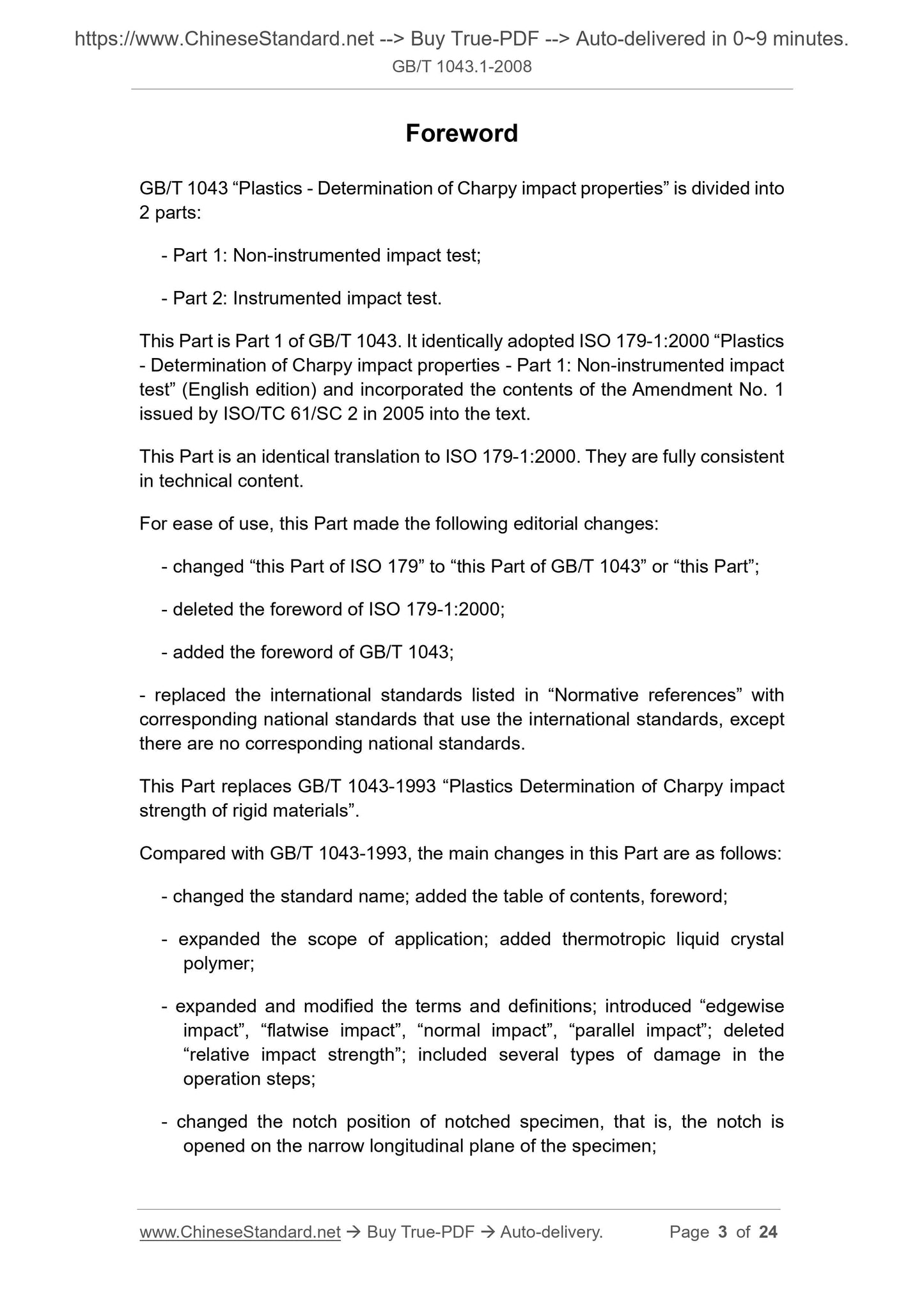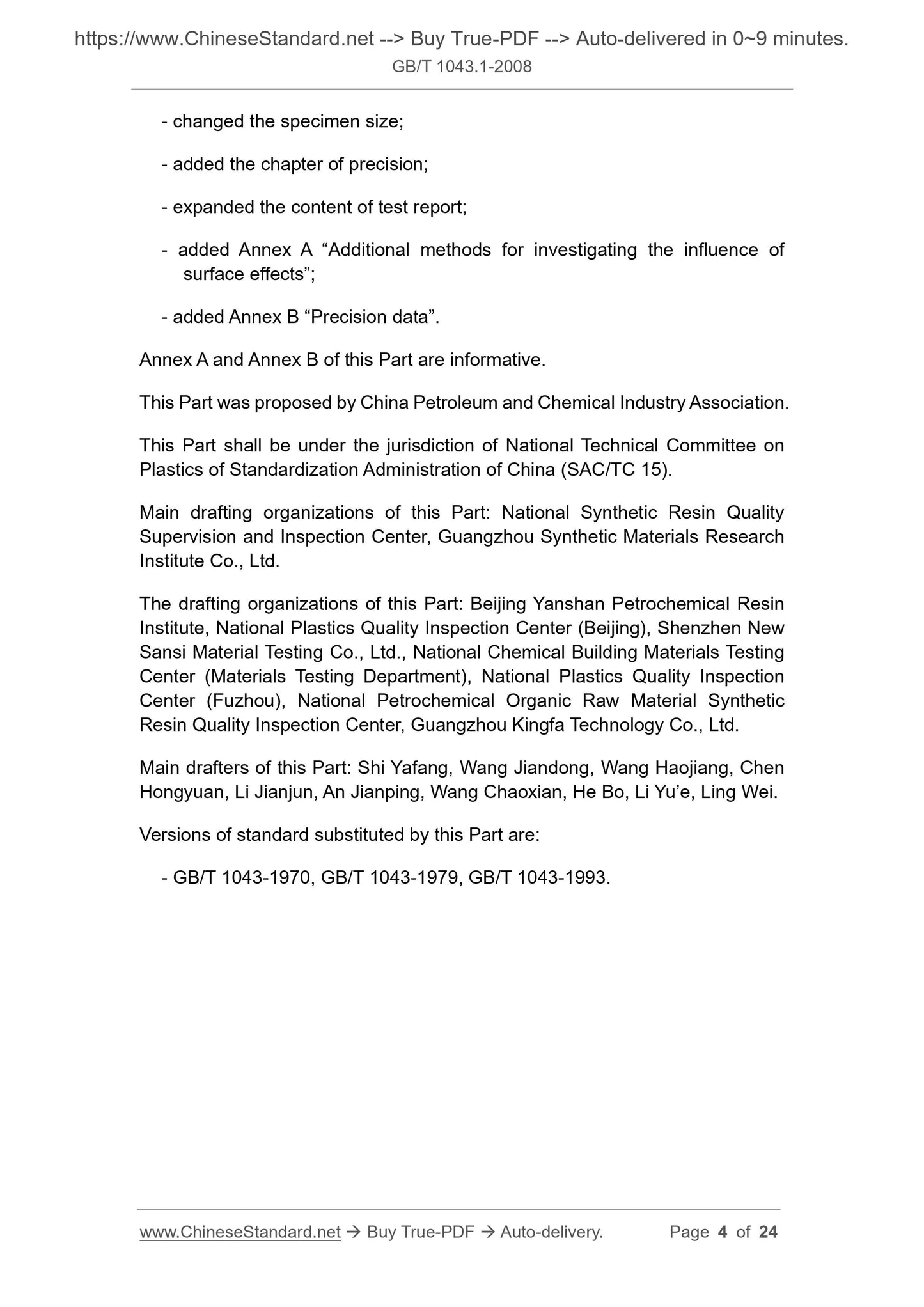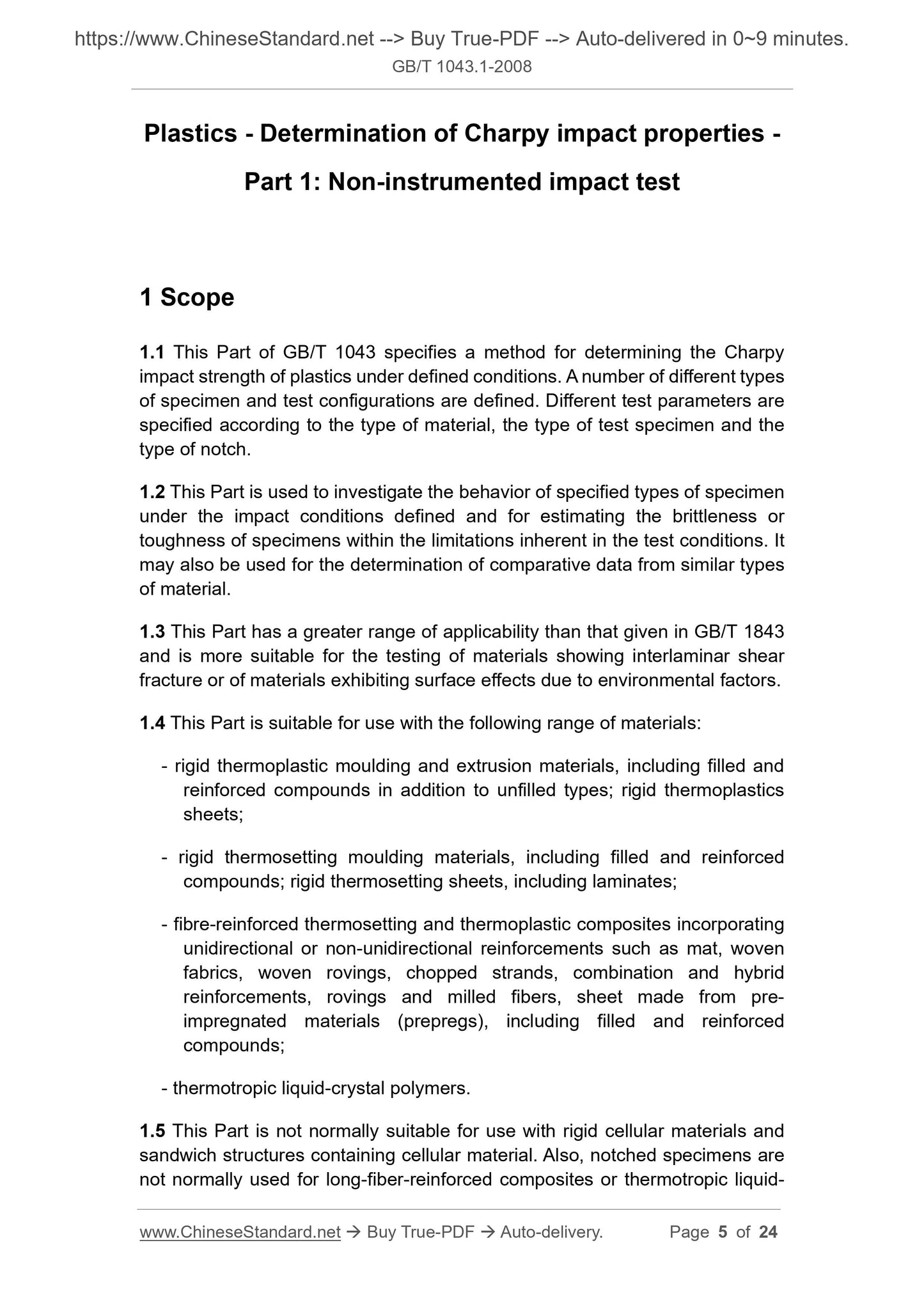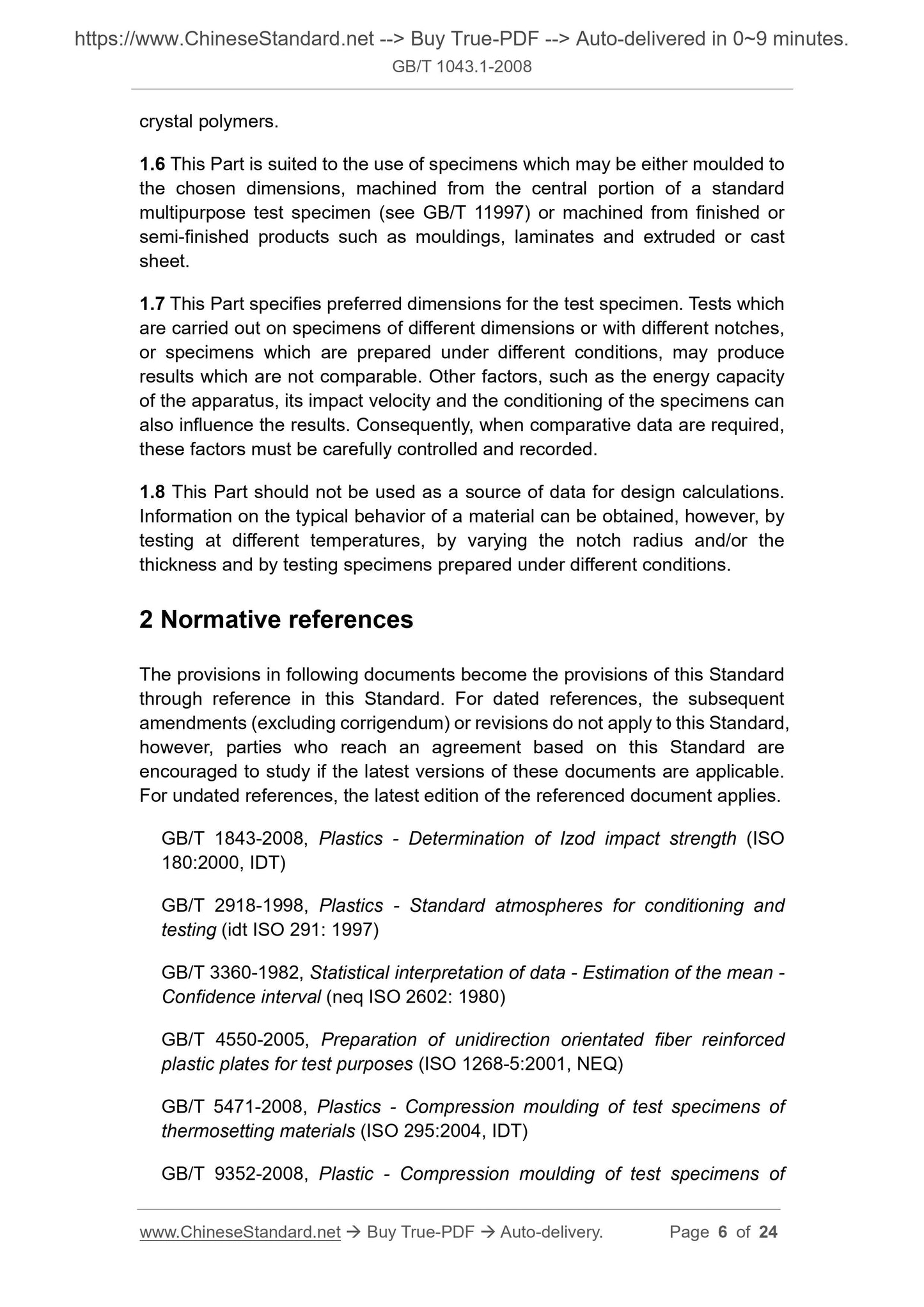1
/
de
6
PayPal, credit cards. Download editable-PDF and invoice in 1 second!
GB/T 1043.1-2008 English PDF (GBT1043.1-2008)
GB/T 1043.1-2008 English PDF (GBT1043.1-2008)
Prix habituel
$155.00 USD
Prix habituel
Prix promotionnel
$155.00 USD
Prix unitaire
/
par
Frais d'expédition calculés à l'étape de paiement.
Impossible de charger la disponibilité du service de retrait
Delivery: 3 seconds. Download true-PDF + Invoice.
Get QUOTATION in 1-minute: Click GB/T 1043.1-2008
Historical versions: GB/T 1043.1-2008
Preview True-PDF (Reload/Scroll if blank)
GB/T 1043.1-2008: Plastics -- Determination of Charpy impact properties -- Part 1: Non-instrumented impact test
GB/T 1043.1-2008
GB
NATIONAL STANDARD OF THE
PEOPLE’S REPUBLIC OF CHINA
ICS 83.140
G 32
GB/T 1043.1-2008 / ISO 179-1:2000
Replacing GB/T 1043-1993
Plastics - Determination of Charpy impact properties -
Part 1: Non-instrumented impact test
(ISO 179-1:2000, IDT)
ISSUED ON: AUGUST 04, 2008
IMPLEMENTED ON: APRIL 01, 2009
Issued by: General Administration of Quality Supervision, Inspection and
Quarantine;
Standardization Administration of the People's Republic of
China.
Table of Contents
Foreword ... 3
1 Scope ... 5
2 Normative references ... 6
3 Terms and definitions ... 7
4 Principle ... 11
5 Apparatus ... 11
6 Test specimens ... 11
7 Procedure ... 16
8 Calculation and expression of results ... 17
9 Precision ... 18
10 Test report ... 18
Annex A (informative) Additional methods for investigating the influence of
surface effects ... 21
Annex B (informative) Precision data ... 22
Foreword
GB/T 1043 “Plastics - Determination of Charpy impact properties” is divided into
2 parts:
- Part 1: Non-instrumented impact test;
- Part 2: Instrumented impact test.
This Part is Part 1 of GB/T 1043. It identically adopted ISO 179-1:2000 “Plastics
- Determination of Charpy impact properties - Part 1: Non-instrumented impact
test” (English edition) and incorporated the contents of the Amendment No. 1
issued by ISO/TC 61/SC 2 in 2005 into the text.
This Part is an identical translation to ISO 179-1:2000. They are fully consistent
in technical content.
For ease of use, this Part made the following editorial changes:
- changed “this Part of ISO 179” to “this Part of GB/T 1043” or “this Part”;
- deleted the foreword of ISO 179-1:2000;
- added the foreword of GB/T 1043;
- replaced the international standards listed in “Normative references” with
corresponding national standards that use the international standards, except
there are no corresponding national standards.
This Part replaces GB/T 1043-1993 “Plastics Determination of Charpy impact
strength of rigid materials”.
Compared with GB/T 1043-1993, the main changes in this Part are as follows:
- changed the standard name; added the table of contents, foreword;
- expanded the scope of application; added thermotropic liquid crystal
polymer;
- expanded and modified the terms and definitions; introduced “edgewise
impact”, “flatwise impact”, “normal impact”, “parallel impact”; deleted
“relative impact strength”; included several types of damage in the
operation steps;
- changed the notch position of notched specimen, that is, the notch is
opened on the narrow longitudinal plane of the specimen;
- changed the specimen size;
- added the chapter of precision;
- expanded the content of test report;
- added Annex A “Additional methods for investigating the influence of
surface effects”;
- added Annex B “Precision data”.
Annex A and Annex B of this Part are informative.
This Part was proposed by China Petroleum and Chemical Industry Association.
This Part shall be under the jurisdiction of National Technical Committee on
Plastics of Standardization Administration of China (SAC/TC 15).
Main drafting organizations of this Part: National Synthetic Resin Quality
Supervision and Inspection Center, Guangzhou Synthetic Materials Research
Institute Co., Ltd.
The drafting organizations of this Part: Beijing Yanshan Petrochemical Resin
Institute, National Plastics Quality Inspection Center (Beijing), Shenzhen New
Sansi Material Testing Co., Ltd., National Chemical Building Materials Testing
Center (Materials Testing Department), National Plastics Quality Inspection
Center (Fuzhou), National Petrochemical Organic Raw Material Synthetic
Resin Quality Inspection Center, Guangzhou Kingfa Technology Co., Ltd.
Main drafters of this Part: Shi Yafang, Wang Jiandong, Wang Haojiang, Chen
Hongyuan, Li Jianjun, An Jianping, Wang Chaoxian, He Bo, Li Yu’e, Ling Wei.
Versions of standard substituted by this Part are:
- GB/T 1043-1970, GB/T 1043-1979, GB/T 1043-1993.
Plastics - Determination of Charpy impact properties -
Part 1: Non-instrumented impact test
1 Scope
1.1 This Part of GB/T 1043 specifies a method for determining the Charpy
impact strength of plastics under defined conditions. A number of different types
of specimen and test configurations are defined. Different test parameters are
specified according to the type of material, the type of test specimen and the
type of notch.
1.2 This Part is used to investigate the behavior of specified types of specimen
under the impact conditions defined and for estimating the brittleness or
toughness of specimens within the limitations inherent in the test conditions. It
may also be used for the determination of comparative data from similar types
of material.
1.3 This Part has a greater range of applicability than that given in GB/T 1843
and is more suitable for the testing of materials showing interlaminar shear
fracture or of materials exhibiting surface effects due to environmental factors.
1.4 This Part is suitable for use with the following range of materials:
- rigid thermoplastic moulding and extrusion materials, including filled and
reinforced compounds in addition to unfilled types; rigid thermoplastics
sheets;
- rigid thermosetting moulding materials, including filled and reinforced
compounds; rigid thermosetting sheets, including laminates;
- fibre-reinforced thermosetting and thermoplastic composites incorporating
unidirectional or non-unidirectional reinforcements such as mat, woven
fabrics, woven rovings, chopped strands, combination and hybrid
reinforcements, rovings and milled fibers, sheet made from pre-
impregnated materials (prepregs), including filled and reinforced
compounds;
- thermotropic liquid-crystal polymers.
1.5 This Part is not normally suitable for use with rigid cellular materials and
sandwich structures containing cellular material. Also, notched specimens are
not normally used for long-fiber-reinforced composites or thermotropic liquid-
crystal polymers.
1.6 This Part is suited to the use of specimens which may be either moulded to
the chosen dimensions, machined from the central portion of a standard
multipurpose test specimen (see GB/T 11997) or machined from finished or
semi-finished products such as mouldings, laminates and extruded or cast
sheet.
1.7 This Part specifies preferred dimensions for the test specimen. Tests which
are carried out on specimens of different dimensions or with different notches,
or specimens which are prepared under different conditions, may produce
results which are not comparable. Other factors, such as the energy capacity
of the apparatus, its impact velocity and the conditioning of the specimens can
also influence the results. Consequently, when comparative data are required,
these factors must be carefully controlled and recorded.
1.8 This Part should not be used as a source of data for design calculations.
Information on the typical behavior of a material can be obtained, however, by
testing at different temperatures, by varying the notch radius and/or the
thickness and by testing specimens prepared under different conditions.
2 Normative references
The provisions in following documents become the provisions of this Standard
through reference in this Standard. For dated references, the subsequent
amendments (excluding corrigendum) or revisions do not apply t...
Get QUOTATION in 1-minute: Click GB/T 1043.1-2008
Historical versions: GB/T 1043.1-2008
Preview True-PDF (Reload/Scroll if blank)
GB/T 1043.1-2008: Plastics -- Determination of Charpy impact properties -- Part 1: Non-instrumented impact test
GB/T 1043.1-2008
GB
NATIONAL STANDARD OF THE
PEOPLE’S REPUBLIC OF CHINA
ICS 83.140
G 32
GB/T 1043.1-2008 / ISO 179-1:2000
Replacing GB/T 1043-1993
Plastics - Determination of Charpy impact properties -
Part 1: Non-instrumented impact test
(ISO 179-1:2000, IDT)
ISSUED ON: AUGUST 04, 2008
IMPLEMENTED ON: APRIL 01, 2009
Issued by: General Administration of Quality Supervision, Inspection and
Quarantine;
Standardization Administration of the People's Republic of
China.
Table of Contents
Foreword ... 3
1 Scope ... 5
2 Normative references ... 6
3 Terms and definitions ... 7
4 Principle ... 11
5 Apparatus ... 11
6 Test specimens ... 11
7 Procedure ... 16
8 Calculation and expression of results ... 17
9 Precision ... 18
10 Test report ... 18
Annex A (informative) Additional methods for investigating the influence of
surface effects ... 21
Annex B (informative) Precision data ... 22
Foreword
GB/T 1043 “Plastics - Determination of Charpy impact properties” is divided into
2 parts:
- Part 1: Non-instrumented impact test;
- Part 2: Instrumented impact test.
This Part is Part 1 of GB/T 1043. It identically adopted ISO 179-1:2000 “Plastics
- Determination of Charpy impact properties - Part 1: Non-instrumented impact
test” (English edition) and incorporated the contents of the Amendment No. 1
issued by ISO/TC 61/SC 2 in 2005 into the text.
This Part is an identical translation to ISO 179-1:2000. They are fully consistent
in technical content.
For ease of use, this Part made the following editorial changes:
- changed “this Part of ISO 179” to “this Part of GB/T 1043” or “this Part”;
- deleted the foreword of ISO 179-1:2000;
- added the foreword of GB/T 1043;
- replaced the international standards listed in “Normative references” with
corresponding national standards that use the international standards, except
there are no corresponding national standards.
This Part replaces GB/T 1043-1993 “Plastics Determination of Charpy impact
strength of rigid materials”.
Compared with GB/T 1043-1993, the main changes in this Part are as follows:
- changed the standard name; added the table of contents, foreword;
- expanded the scope of application; added thermotropic liquid crystal
polymer;
- expanded and modified the terms and definitions; introduced “edgewise
impact”, “flatwise impact”, “normal impact”, “parallel impact”; deleted
“relative impact strength”; included several types of damage in the
operation steps;
- changed the notch position of notched specimen, that is, the notch is
opened on the narrow longitudinal plane of the specimen;
- changed the specimen size;
- added the chapter of precision;
- expanded the content of test report;
- added Annex A “Additional methods for investigating the influence of
surface effects”;
- added Annex B “Precision data”.
Annex A and Annex B of this Part are informative.
This Part was proposed by China Petroleum and Chemical Industry Association.
This Part shall be under the jurisdiction of National Technical Committee on
Plastics of Standardization Administration of China (SAC/TC 15).
Main drafting organizations of this Part: National Synthetic Resin Quality
Supervision and Inspection Center, Guangzhou Synthetic Materials Research
Institute Co., Ltd.
The drafting organizations of this Part: Beijing Yanshan Petrochemical Resin
Institute, National Plastics Quality Inspection Center (Beijing), Shenzhen New
Sansi Material Testing Co., Ltd., National Chemical Building Materials Testing
Center (Materials Testing Department), National Plastics Quality Inspection
Center (Fuzhou), National Petrochemical Organic Raw Material Synthetic
Resin Quality Inspection Center, Guangzhou Kingfa Technology Co., Ltd.
Main drafters of this Part: Shi Yafang, Wang Jiandong, Wang Haojiang, Chen
Hongyuan, Li Jianjun, An Jianping, Wang Chaoxian, He Bo, Li Yu’e, Ling Wei.
Versions of standard substituted by this Part are:
- GB/T 1043-1970, GB/T 1043-1979, GB/T 1043-1993.
Plastics - Determination of Charpy impact properties -
Part 1: Non-instrumented impact test
1 Scope
1.1 This Part of GB/T 1043 specifies a method for determining the Charpy
impact strength of plastics under defined conditions. A number of different types
of specimen and test configurations are defined. Different test parameters are
specified according to the type of material, the type of test specimen and the
type of notch.
1.2 This Part is used to investigate the behavior of specified types of specimen
under the impact conditions defined and for estimating the brittleness or
toughness of specimens within the limitations inherent in the test conditions. It
may also be used for the determination of comparative data from similar types
of material.
1.3 This Part has a greater range of applicability than that given in GB/T 1843
and is more suitable for the testing of materials showing interlaminar shear
fracture or of materials exhibiting surface effects due to environmental factors.
1.4 This Part is suitable for use with the following range of materials:
- rigid thermoplastic moulding and extrusion materials, including filled and
reinforced compounds in addition to unfilled types; rigid thermoplastics
sheets;
- rigid thermosetting moulding materials, including filled and reinforced
compounds; rigid thermosetting sheets, including laminates;
- fibre-reinforced thermosetting and thermoplastic composites incorporating
unidirectional or non-unidirectional reinforcements such as mat, woven
fabrics, woven rovings, chopped strands, combination and hybrid
reinforcements, rovings and milled fibers, sheet made from pre-
impregnated materials (prepregs), including filled and reinforced
compounds;
- thermotropic liquid-crystal polymers.
1.5 This Part is not normally suitable for use with rigid cellular materials and
sandwich structures containing cellular material. Also, notched specimens are
not normally used for long-fiber-reinforced composites or thermotropic liquid-
crystal polymers.
1.6 This Part is suited to the use of specimens which may be either moulded to
the chosen dimensions, machined from the central portion of a standard
multipurpose test specimen (see GB/T 11997) or machined from finished or
semi-finished products such as mouldings, laminates and extruded or cast
sheet.
1.7 This Part specifies preferred dimensions for the test specimen. Tests which
are carried out on specimens of different dimensions or with different notches,
or specimens which are prepared under different conditions, may produce
results which are not comparable. Other factors, such as the energy capacity
of the apparatus, its impact velocity and the conditioning of the specimens can
also influence the results. Consequently, when comparative data are required,
these factors must be carefully controlled and recorded.
1.8 This Part should not be used as a source of data for design calculations.
Information on the typical behavior of a material can be obtained, however, by
testing at different temperatures, by varying the notch radius and/or the
thickness and by testing specimens prepared under different conditions.
2 Normative references
The provisions in following documents become the provisions of this Standard
through reference in this Standard. For dated references, the subsequent
amendments (excluding corrigendum) or revisions do not apply t...
Share
